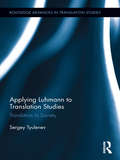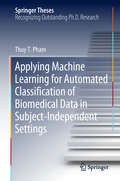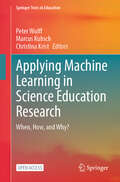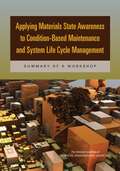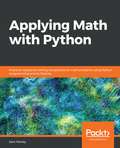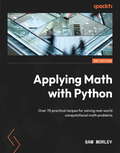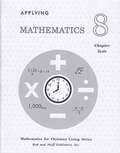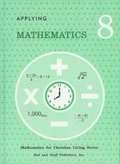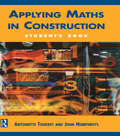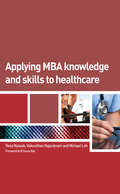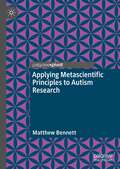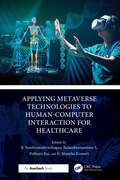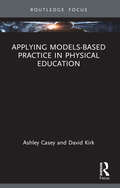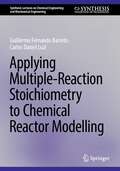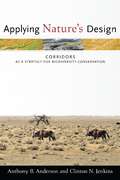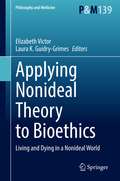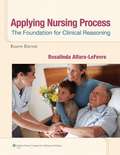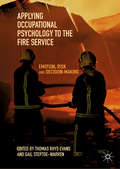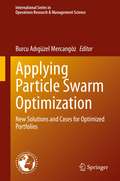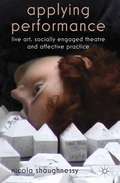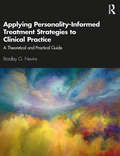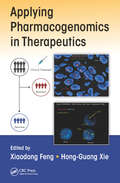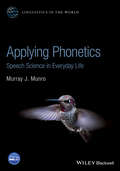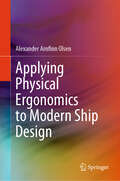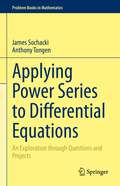- Table View
- List View
Applying Luhmann to Translation Studies: Translation in Society (Routledge Advances in Translation and Interpreting Studies)
by Sergey TyulenevThis book deals with one of the most prominent and promising developments in modern Translation Studies--the sociology of translation. Tyulenev develops an original way of applying Luhmann's Social Systems Theory to translation, viewing translation as a social-systemic boundary phenomenon. The book consists of two major parts: in the first, translation is described as a system in its own right with its systemic properties; in the second part, translation is viewed as a social subsystem and as a boundary phenomenon in the overall social system.
Applying Machine Learning for Automated Classification of Biomedical Data in Subject-Independent Settings (Springer Theses)
by Thuy T. PhamThis book describes efforts to improve subject-independent automated classification techniques using a better feature extraction method and a more efficient model of classification. It evaluates three popular saliency criteria for feature selection, showing that they share common limitations, including time-consuming and subjective manual de-facto standard practice, and that existing automated efforts have been predominantly used for subject dependent setting. It then proposes a novel approach for anomaly detection, demonstrating its effectiveness and accuracy for automated classification of biomedical data, and arguing its applicability to a wider range of unsupervised machine learning applications in subject-independent settings.
Applying Machine Learning in Science Education Research: When, How, and Why? (Springer Texts in Education)
by Peter Wulff Marcus Kubsch Christina KristThis open access textbook offers science education researchers a hands-on guide for learning, critically examining, and integrating machine learning (ML) methods into their science education research projects. These methods power many artificial intelligence (AI)-based technologies and are widely adopted in science education research. ML can expand the methodological toolkit of science education researchers and provide novel opportunities to gain insights on science-related learning and teaching processes, however, applying ML poses novel challenges and is not suitable for every research context. The volume first introduces the theoretical underpinnings of ML methods and their connections to methodological commitments in science education research. It then presents exemplar case studies of ML uses in both formal and informal science education settings. These case studies include open-source data, executable programming code, and explanations of the methodological criteria and commitments guiding ML use in each case. The textbook concludes with a discussion of opportunities and potential future directions for ML in science education. This textbook is a valuable resource for science education lecturers, researchers, under-graduate, graduate and postgraduate students seeking new ways to apply ML in their work.
Applying Materials State Awareness to Condition-Based Maintenance and System Life Cycle Management: Summary of a Workshop
by Division on Engineering and Physical Sciences National Materials and Manufacturing Board Defense Materials Manufacturing and Infrastructure Standing Committee Robert J. Katt National Academies of Sciences, Engineering, and MedicineIn August 2014, the committee on Defense Materials Manufacturing and Infrastructure convened a workshop to discuss issues related to applying materials state awareness to condition-based maintenance and system life cycle management. The workshop was structured around three focal topics: (1) advances in metrology and experimental methods, (2) advances in physics-based models for assessment, and (3) advances in databases and diagnostic technologies. This report summarizes the discussions and presentations from this workshop.
Applying Math with Python: Practical recipes for solving computational math problems using Python programming and its libraries
by Sam MorleyThis book is for professional programmers and students looking to solve mathematical problems computationally using Python. Advanced mathematics knowledge is not a requirement, but a basic knowledge of mathematics will help you to get the most out of this book. The book assumes familiarity with Python concepts of data structures.
Applying Math with Python: Over 70 practical recipes for solving real-world computational math problems, 2nd Edition
by Sam MorleyDiscover easy-to-follow solutions and techniques to help you to implement applied mathematical concepts such as probability, calculus, and equations using Python's numeric and scientific librariesKey FeaturesCompute complex mathematical problems using programming logic with the help of step-by-step recipesLearn how to use Python libraries for computation, mathematical modeling, and statisticsDiscover simple yet effective techniques for solving mathematical equations and apply them in real-world statisticsBook DescriptionThe updated edition of Applying Math with Python will help you solve complex problems in a wide variety of mathematical fields in simple and efficient ways. Old recipes have been revised for new libraries and several recipes have been added to demonstrate new tools such as JAX.You'll start by refreshing your knowledge of several core mathematical fields and learn about packages covered in Python's scientific stack, including NumPy, SciPy, and Matplotlib. As you progress, you'll gradually get to grips with more advanced topics of calculus, probability, and networks (graph theory). Once you've developed a solid base in these topics, you'll have the confidence to set out on math adventures with Python as you explore Python's applications in data science and statistics, forecasting, geometry, and optimization. The final chapters will take you through a collection of miscellaneous problems, including working with specific data formats and accelerating code.By the end of this book, you'll have an arsenal of practical coding solutions that can be used and modified to solve a wide range of practical problems in computational mathematics and data science.What you will learnBecome familiar with basic Python packages, tools, and libraries for solving mathematical problemsExplore real-world applications of mathematics to reduce a problem in optimizationUnderstand the core concepts of applied mathematics and their application in computer scienceFind out how to choose the most suitable package, tool, or technique to solve a problemImplement basic mathematical plotting, change plot styles, and add labels to plots using MatplotlibGet to grips with probability theory with the Bayesian inference and Markov Chain Monte Carlo (MCMC) methodsWho this book is forWhether you are a professional programmer or a student looking to solve mathematical problems computationally using Python, this is the book for you. Advanced mathematics proficiency is not a prerequisite, but basic knowledge of mathematics will help you to get the most out of this Python math book. Familiarity with the concepts of data structures in Python is assumed.
Applying Mathematics: Tests (Mathematics For Christian Living)
by Glenn Auker Seth Rudolph Keith KriederApplying Mathematics Grade 8 Math Chapter Tests
Applying Mathematics: Grade 8 (Mathematics For Christian Living Series)
by John Mark Shenk Marian Baltozer Amy Herr Christine Collins Glenn Auker Seth Rudolph Keith KriederThe teacher's manual comes in two volumes. Each lesson has full-size pupil's pages, with answers filled in. Extra pages guide the teacher in lesson preparation and include answer keys for quizzes, speed teats, and chapter tests.
Applying Maths in Construction
by Antoinette Tourret John HumphreysThis book and its accompanying Teacher's Pack are the result of a project, supported by the Nuffield Foundation, to provide flexible learning materials for the Basic Application of Number core skill for both the NVQs and GNVQ in construction and the construction crafts. The student book uses a unique approach to explain how mathematical principles apply to construction tasks. Each chapter forms an individual construction project and uses the full range of number skills from the fundamentals of addition and subtraction to statistics, trigonometry and technical drawing. Successfully completed projects provide the student with the required portfolio of evidence for their course. Notes throughout the text refer the student to the relevant module in the Teacher's Pack, which contains assessments, tests and detailed explanations of the number skills needed to complete the projects.
Applying MBA Knowledge and Skills to Healthcare
by Reza Nassab Vaikunthan Rajaratnam Michael LohClinicians increasingly need a firm grasp of the fundamental principles of business management, finance and related subjects. Even so, business disciplines are still rarely taught during medical training, while busy practices and complicated accounting tasks mean that gaining business acumen 'on the job' is impractical for many. As a result, increasing numbers of clinicians learn the skills they need by taking an MBA (Masters in Business Administration). While an MBA may be the answer for some, the formidable costs and time commitment it demands leave many busy practitioners seeking more accessible options. This book provides a readable, tightly organised alternative - a primer on MBA principles and their practical application. Twelve compact, carefully structured modules cover the entire gamut of a business education, from basic finance and accounting principles, to strategic management methods and leadership theories. Unlike some similar texts, this book is designed to be light in tone, easy to read and digest, and thoroughly practical. Busy clinicians, academic surgeons, administrative physicians and other healthcare professionals will find this an invaluable resource in understanding the core principles of business management. Allied medical professionals, and nurses will also find it useful, as will interview candidates who increasingly face management questions as part of selection processes. 'An invaluable resource in understanding the core principles of business management, and in learning how to apply them. For busy clinicians, the value proposition is enormous in terms of the knowledge gained, versus the amount of reading required to capture what the authors have so capably managed to distill between the covers. The authors have done a remarkable task in capturing the latest concepts and thinking in the business management arena [and] the essence of an entire MBA education, and customise it for healthcare professionals. A delight.' From the Foreword by B Sonny Bal
Applying Metascientific Principles to Autism Research
by Matthew BennettThis book presents several metascientific strategies and explains how they can be used to improve research about the autism spectrum. It begins with an introduction to the field of metascience and the benefits that it brings to academic disciplines and society. It then outlines recommendations that researchers can adopt so that they do not incorporate specious autism research from predatory publishers into their research activities. An introduction to reproducibility and strategies that can improve the reproducibility of autism research are then outlined. This is followed by chapters about improving the peer review process and reducing the prospect of questionable research practices from occurring. This book concludes with a chapter about strategies that researchers can use to improve the participation of autistics in research. Such knowledge will equip academics, regardless of their experience, with the skills and expertise they need to produce high-quality and inclusive research about the autism spectrum.
Applying Metaverse Technologies to Human-Computer Interaction for Healthcare
by Balasubramaniam S Pethuru Raj K. Shantha KumariThe concept of the metaverse signifies the forthcoming stage of development of the Internet, wherein it will facilitate the creation of virtual worlds that are enduring, decentralized, and capable of providing immersive experiences in real time. The metaverse has vast potential for utilization in the domains of life sciences and healthcare, hence motivating investigations in contemporary trends, early adoption use cases, and the forthcoming opportunities it presents. The metaverse also possesses the capacity to fundamentally transform decentralized clinical trials through the elimination of physical and geographical constraints. This change in thinking entails the relocation of clinical trials from conventional settings to the comfort and convenience of patients’ residences, resulting in improvements in health behavior, medication adherence, remote monitoring, and other associated factors.Applying Metaverse Technologies to Human-Computer Interaction for Healthcare focuses on the current developments in the metaverse, investigates its applications in the life sciences and healthcare industry based on metaverse powered human−computer interactions (HCI), analyzes early adoption use cases that provide measurable commercial benefits, and anticipates prospects in this rapidly evolving domain.The book examines the treatment, management, and prevention of illnesses with the use of immersive therapeutics that use augmented reality (AR), virtual reality (VR), and mixed reality (MR). It examines applications in cognitive therapy, support groups, psychiatric examinations, rehabilitation, and even physical therapy The book covers how healthcare practitioners have the capability to provide such services as diagnosis, treatment, monitoring, and care in remote settings, through the utilization of AR headsets and wearable devices. It concludes by discussing the continuous development of technology to facilitate the growth and maturation of the metaverse, hence enabling substantial business benefits for the life sciences and healthcare industries.
Applying Models-based Practice in Physical Education (Routledge Focus on Sport Pedagogy)
by David Kirk Ashley CaseyThis book is a concise, practical introduction to Models-based Practice (MbP), a transformative approach to physical education and sport pedagogy that uses multiple pedagogical models in the design and delivery of physical education programs.The book introduces the core concepts underpinning the MbP approach – including models such as teaching games for understanding, sport education, cooperative learning and health-based physical education – and examines its significance for teaching, learning, curriculum and assessment. With an emphasis on evidence-based practice and student learning, and full of practical tips and features to encourage critical thinking, the book explains how to develop successful, flexible and sustainable MbP programs that can deliver real educational and health and well-being benefits for children and young people, in schools or in after-school or community-based settings.Applying Models-based Practice in Physical Education is intended for current and prospective teachers of physical education who are responsible for organising and enacting programs at all grade levels. It will also be of interest to researchers, students and other sport pedagogy practitioners, such as coaches who are looking for new and innovative ways of working with children and young people.
Applying Multiple-Reaction Stoichiometry to Chemical Reactor Modelling (Synthesis Lectures on Chemical Engineering and Biochemical Engineering)
by Guillermo Fernando Barreto Carlos Daniel LuziThis book delves into the realm of Chemical Reaction Engineering (CRE) by showcasing the practical application of multiple-reaction stoichiometry. The authors critically assess various approaches commonly taught in undergraduate CRE courses to establish the relationships between changes in chemical species. In doing so, they propose an innovative conceptual alternative that is specifically tailored for undergraduate lectures. The book carefully selects composition measures that effectively harness the power of stoichiometric relationships in elementary reacting systems and models, which are typically covered in these courses. Going beyond the basics, it also offers a profound discussion on the value of chemical stoichiometry for tackling more intricate reaction systems and detailed models. Moreover, the book presents a simplified procedure that minimizes the reliance on complex linear algebra techniques, making the book accessible to a wider range of readers.
Applying Nature's Design: Corridors as a Strategy for Biodiversity Conservation (Issues, Cases, and Methods in Biodiversity Conservation)
by Anthony Anderson Clinton JenkinsThe fragmenting of habitats is endangering animal populations and degrading or destroying many plant populations throughout the world. To address this problem, conservationists have increasingly turned to biological corridors, areas of land set aside to facilitate the movement of species and ecological processes. However, while hundreds of corridor initiatives are under way worldwide, there is little practical information to guide their design, location, and management. <P><P>Applying Nature's Design offers a comprehensive overview of current knowledge on corridors, their design, and their implementation. Anthony B. Anderson and Clinton N. Jenkins examine a variety of conceptual and practical issues associated with corridors and provide detailed case studies from around the world. Their work considers how to manage and govern corridors, how to build support among various interest groups for corridors, and the obstacles to implementation. In addition to assessing various environmental and ecological challenges, the authors are the first to consider the importance of socioeconomic and political issues in creating and maintaining corridors.
Applying Nonideal Theory to Bioethics: Living and Dying in a Nonideal World (Philosophy and Medicine #139)
by Elizabeth Victor Laura K. Guidry-GrimesThis book offers new essays exploring concepts and applications of nonideal theory in bioethics. Nonideal theory refers to an analytic approach to moral and political philosophy (especially in relation to justice), according to which we should not assume that there will be perfect compliance with principles, that there will be favorable circumstances for just institutions and right action, or that reasoners are capable of being impartial. Nonideal theory takes the world as it actually is, in all of its imperfections. Bioethicists have called for greater attention to how nonideal theory can serve as a guide in the messy realities they face daily. Although many bioethicists implicitly assume nonideal theory in their work, there is the need for more explicit engagement with this theoretical outlook. A nonideal approach to bioethics would start by examining the sociopolitical realities of healthcare and the embeddedness of moral actors in those realities. How are bioethicists to navigate systemic injustices when completing research, giving guidance for patient care, and contributing to medical and public health policies? When there are no good options and when moral agents are enmeshed in their sociopolitical viewpoints, how should moral theorizing proceed? What do bioethical issues and principles look like from the perspective of historically marginalized persons? These are just a few of the questions that motivate nonideal theory within bioethics. This book begins in Part I with an overview of the foundational tenets of nonideal theory, what nonideal theory can offer bioethics, and why it may be preferable to ideal theory in addressing moral dilemmas in the clinic and beyond. In Part II, authors discuss applications of nonideal theory in many areas of bioethics, including reflections on environmental harms, racism and minority health, healthcare injustices during incarceration and detention, and other vulnerabilities experienced by patients from clinical and public health perspectives. The chapters within each section demonstrate the breadth in scope that nonideal theory encompasses, bringing together diverse theorists and approaches into one collection.
Applying Nursing Process: The Foundation for Clinical Reasoning
by Rosalinda Alfaro-LeFevreBecause principles of nursing process are the building blocks for all care models, the nursing process is the first model nurses need to learn to “think like a nurse.” This trusted resource provides the practical guidance needed to understand and apply each phase of the nursing process, with an increased emphasis on developing both critical thinking and clinical reasoning skills. With an easy-to-follow and engaging writing style, the author provides strategies, tools, and abundant examples to help nurses develop the skills they need to thrive in today’s complex health care setting.
Applying Occupational Psychology to the Fire Service: Emotion, Risk and Decision-Making
by Thomas Rhys Evans Gail Steptoe-WarrenApplying Occupational Psychology in the Fire Service: Emotion, Risk and Decision-Making provides readers with an overview of the latest research informing the policies, procedures and practices of those working on the ground in the UK Fire Service. Using best-practice principles and cutting-edge theory, the current text demonstrates how occupational psychology can be applied to fire services around the globe to improve individual, management, and organisational decisions. The authors aim to provide students, trainees, practitioners and fire personnel with a unique insight into a range of topics, including resilience, injury, work related wellbeing, community engagement as well as decision making and operational preparedness. This book represents a call to arms for more robust practices to support the Fire Service, highlighting the psychological factors involved in the firefighter occupation and paving the way towards a better understanding of emotion, risk, safety, and decision-making within the fire context.
Applying Particle Swarm Optimization: New Solutions and Cases for Optimized Portfolios (International Series in Operations Research & Management Science #306)
by Burcu Adıgüzel MercangözThis book explains the theoretical structure of particle swarm optimization (PSO) and focuses on the application of PSO to portfolio optimization problems. The general goal of portfolio optimization is to find a solution that provides the highest expected return at each level of portfolio risk. According to H. Markowitz’s portfolio selection theory, as new assets are added to an investment portfolio, the total risk of the portfolio’s decreases depending on the correlations of asset returns, while the expected return on the portfolio represents the weighted average of the expected returns for each asset.The book explains PSO in detail and demonstrates how to implement Markowitz’s portfolio optimization approach using PSO. In addition, it expands on the Markowitz model and seeks to improve the solution-finding process with the aid of various algorithms. In short, the book provides researchers, teachers, engineers, managers and practitioners with many tools they need to apply the PSO technique to portfolio optimization.
Applying Performance
by Nicola ShaughnessyThis book draws upon cognitive and affect theory to examine applications of contemporary performance practices in educational, social and community contexts. The writing is situated in the spaces between making and performance, exploring the processes of creating work defined variously as collaborative, participatory and socially engaged.
Applying Personality-Informed Treatment Strategies to Clinical Practice: A Theoretical and Practical Guide
by Bradley G NevinsA strategic approach for positive change tailored to the unique qualities of different individuals, this text assists readers in factoring personality functioning into any psychotherapeutic undertaking, providing a guide for comprehensive Personality-Informed assessment and treatment planning. Drawing upon research from across scientific disciplines, chapters emphasize the importance of a multidisciplinary approach in effectuating enduring therapeutic change whilst dealing with clients’ unique personality styles. Also featured is Dr. Nevins’ Personality Wheel, used throughout as a framework for therapeutically addressing the problematic personality patterns, styles, or traits related to most clients' presenting problems and for constructing healthy personality change. Graduate students and professionals will benefit from the book’s key insights into the major contributing factors underlying psychological distress due to maladaptive personality patterns, styles and traits.
Applying Pharmacogenomics in Therapeutics
by Xiaodong Feng Hong-Guang XieRecent advances in high-throughput gene sequencing and other omics biotechnologies have served as a springboard for the field of pharmacogenomics. Pharmacogenomics is now generally accepted as the major determinant of variable drug safety, efficacy, and cost-effectiveness. Therefore, widespread use of pharmacogenomics for patient care has become a
Applying Phonetics: Speech Science in Everyday Life (Linguistics in the World)
by Murray J. MunroA unique and accessible introduction to the field of phonetics through real-life applications and practical examples The dynamic field of phonetics, the science of the structure and function of human speech, has seen exciting technological innovations and new applications in recent years. Applying Phonetics introduces students to the field through a unique exploratory approach that highlights practical applications and focuses on the diverse ways in which the speech sciences influence daily life. Requiring no prior knowledge of linguistics, this accessible, student-friendly textbook introduces the key concepts in phonetics and explains their relevance to contemporary applications. Even students who have completed introductory linguistics courses will discover plenty of new material in this volume. Rather than immediately delving into complex theoretical information, the text presents a brief overview of basic concepts and then uses applications—speech synthesis, forensic speech science, language teaching—to explain the details. This unique approach increases student interest and comprehension, clearly demonstrating how speech science is beneficial to society. Engaging, easily-relatable topics include speech anatomy and physiology, the nature of normal and disordered speech development, the origins of speech, and speech applications in forensics, music, drama, film, and business. Written by a respected expert with over 25 years’ experience teaching linguistics and phonetics, this textbook Explores the wide-ranging applications of phonetics areas such as accessibility, computer speech, education, the fine arts, and business Demonstrates how practical problems have been addressed through phonetics, such as the use of speech analysis for forensic purposes Presents real-life case studies that illustrate fundamental phonetics concepts Includes exercises and activities, discussion questions, an extensive glossary, further readings, and a companion website Applying Phonetics: Speech Science in Everyday Life is an ideal text for undergraduate students with no prior knowledge of linguistics, as well as those needing to expand their knowledge of phonetic principles. It will appeal to students in education, computer science, cognitive science, biology, psychology, business, and music.
Applying Physical Ergonomics to Modern Ship Design
by Alexander Arnfinn OlsenThis book combines and summarizes the myriad rules, regulations, guidance, and guidelines that pertain to the human factor element of vessel design and marine operations. With a focus on physical ergonomics, the book is thoroughly researched and draws on the most current Class rules and industry regulations promulgated by the IMO and other organizations. As such, this book serves as a single point of reference for professionals and students involved in human factors and ergonomics at sea.
Applying Power Series to Differential Equations: An Exploration through Questions and Projects (Problem Books in Mathematics)
by James Sochacki Anthony TongenThis book is aimed to undergraduate STEM majors and to researchers using ordinary differential equations. It covers a wide range of STEM-oriented differential equation problems that can be solved using computational power series methods. Many examples are illustrated with figures and each chapter ends with discovery/research questions most of which are accessible to undergraduate students, and almost all of which may be extended to graduate level research. Methodologies implemented may also be useful for researchers to solve their differential equations analytically or numerically. The textbook can be used as supplementary for undergraduate coursework, graduate research, and for independent study.
